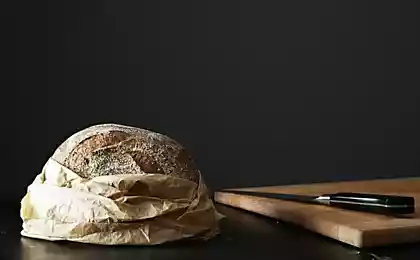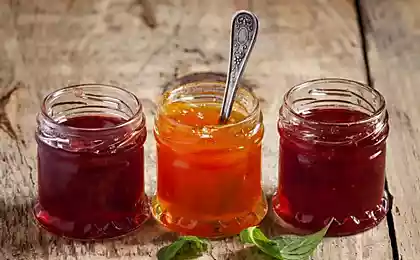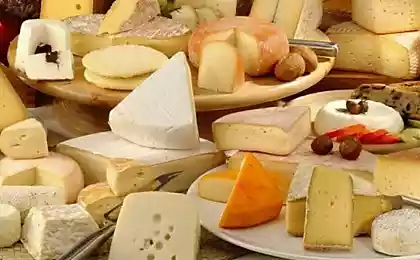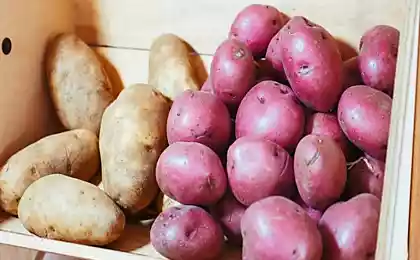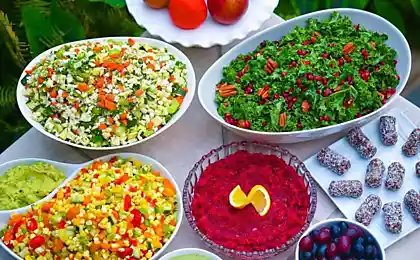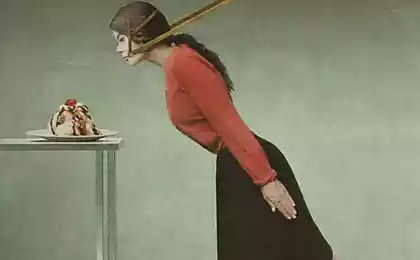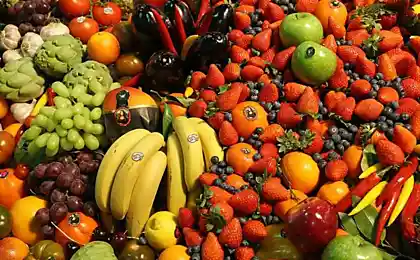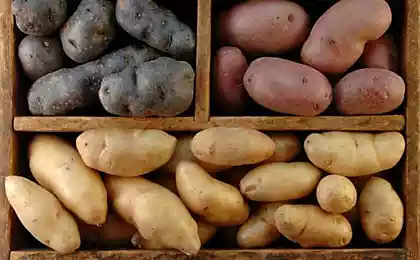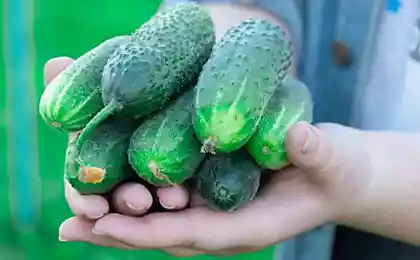659
How to store fruits and vegetables
The high content of vitamins that is known for ripe vegetables and fruit. But how do you know if a ripe banana or a pineapple? Good indicators in these cases are the color and smell of a vegetable or fruit. Of course, no one will come up with the idea to peel the banana and take a bite. Even harder with pineapple: in appearance it is hardly possible to define it yellow, or even green. And then we will help the smell: if the pineapple exudes typical aroma, then it is ripe. The smell is determined by the ripeness and other fruits, such as honeydew melon, mango.
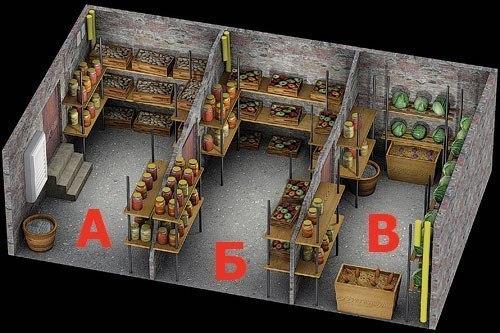
What happens with prolonged and improper storage?
Improper storage of fruits and vegetables are destroyed by vitamins, which are very sensitive to changes in temperature and light. The pulp of the fruit is spoiled, the fruit to become unsightly and inedible. So, for example, when storing the banana in the refrigerator he, like many tropical fruits, which are not used to low temperatures, loses its flavor and aroma. The optimal solution in this case will be storing them at room temperature.
What can and cannot be stored in the refrigerator?
In the refrigerator can be stored: Fruits: apples, apricots, pears, strawberries, figs, cherries, kiwi, nectarine, plums, peaches, table grapes.
Vegetables: artichoke, lettuce, cauliflower, broccoli, carrots, cabbage, radishes, Brussels sprouts, red beets, celery, asparagus, spinach
Do not store in the refrigerator: Fruits: pineapples, avocados, bananas, pomegranate, mango, papaya, citrus, melon. Vegetables: eggplant, cucumbers, zelenogorova beans, potatoes, squash, peppers, tomatoes, zucchini.
What do you mean "proper storage"?
Previously, each house was a cellar and pantry. It was always cool and dark, which in itself is an ideal place for storing vegetables and fruits. At the present day, we have at our disposal mostly only the refrigerator.
Those who have no cellar, he should pay attention to what fruits and vegetables can not be stored in warm and bright spaces. Whatever it was, but each apartment has the area cooler and darker than the others.
There and store Your fruits and vegetables. But the apples are always separate because they release ethylene gas, causing the rest of the over ripeness of the fruit.
One of the most important hormone of ripening – ethylene – sensitive the following vegetables and fruits:
Very high sensitivity to ethylene in kiwifruit, honey melon, mango, broccoli, cauliflower, cabbage, lettuce and Brussels.
High sensitivity in apricot, bananas, pears, nectarine, peaches, papaya, avocado, cucumbers, tomatoes.
The average sensitivity in citrus fruits, leafy vegetables, potatoes, paprika, mushrooms, onions. Apples always store them separately!
What to do with the not ripe fruits and vegetables?
Some fruits are picked fully ripe, others still green. For example, such southern fruit as bananas, in order to take them in the presentation to our Northern latitudes, are harvested green. Ripen, they are on their way and on vegetable bases. Some local fruits like tomatoes and apples are harvested and sold in the state is not ripe. Half green, not ripe tomatoes ripen well in clay vessels.
The fruits, which ripen:
apples, apricots, avocados, bananas, pears, blueberries, figs, guavas, kiwifruit, mangoes, nectarine, papayas, peaches, plums, tomatoes, watermelons.
Fruits that do not ripen:
pineapples, raspberries, strawberries, blackberries, cherries, tangerines, grapes, citrus fruits, eggplant, cucumbers, peppers.
What to do about brown spots?
It often happens that even in supermarkets the fruit, brown spots appear. This means that damaged tissue of the fetus. These fruits contain a lot less vitamins than is healthy. Therefore, when buying you need to carefully examine the item. If You notice in domestic fruit and vegetable these dark spots resulting deposits, they must be cut, and the rest of the fruit to use as usual.
And I would like to give some tips on winter storage of fruits and vegetables. In modern buildings sometimes quite problematic to properly store fruits and vegetables fresh throughout the winter. Warm and dry basements of modern houses wrapped sealed concrete corset. Therefore, observing certain conditions, the autumn harvest is still possible to keep fresh and edible until the end of winter.
Wooden box filled with sand, perfect for storing all root vegetables. The sand should be wet!
Boxes of potatoes should be stored in a dark room (light the potatoes grow). Store away from apples. Apples produce a substance promoting germination of potatoes.
Apples and pears should be stored in wooden boxes or on wooden grills in a cool, well-ventilated area. Cover them with a damp cloth, this stops them from evaporation. The fruits will keep their flavor and not so quick to get wrinkled.
How to store vegetables and prochitannaya stored in wooden boxes or paper bags, from time to time shake them.
Vegetables and fruits can be dried in the dryer or in the oven. Dried vegetables and fruits should be stored in a dry, well-ventilated place.
A dry, well ventilated area suitable for drying on ropes of onions and garlic. Bushes with unripe tomatoes, herbs, flowers store in a dry place in limbo. published
P. S. And remember, only by changing their consumption — together we change the world! ©
Source: vk.com/dacha.life?w=wall-83256656_4327

What happens with prolonged and improper storage?
Improper storage of fruits and vegetables are destroyed by vitamins, which are very sensitive to changes in temperature and light. The pulp of the fruit is spoiled, the fruit to become unsightly and inedible. So, for example, when storing the banana in the refrigerator he, like many tropical fruits, which are not used to low temperatures, loses its flavor and aroma. The optimal solution in this case will be storing them at room temperature.
What can and cannot be stored in the refrigerator?
In the refrigerator can be stored: Fruits: apples, apricots, pears, strawberries, figs, cherries, kiwi, nectarine, plums, peaches, table grapes.
Vegetables: artichoke, lettuce, cauliflower, broccoli, carrots, cabbage, radishes, Brussels sprouts, red beets, celery, asparagus, spinach
Do not store in the refrigerator: Fruits: pineapples, avocados, bananas, pomegranate, mango, papaya, citrus, melon. Vegetables: eggplant, cucumbers, zelenogorova beans, potatoes, squash, peppers, tomatoes, zucchini.
What do you mean "proper storage"?
Previously, each house was a cellar and pantry. It was always cool and dark, which in itself is an ideal place for storing vegetables and fruits. At the present day, we have at our disposal mostly only the refrigerator.
Those who have no cellar, he should pay attention to what fruits and vegetables can not be stored in warm and bright spaces. Whatever it was, but each apartment has the area cooler and darker than the others.
There and store Your fruits and vegetables. But the apples are always separate because they release ethylene gas, causing the rest of the over ripeness of the fruit.
One of the most important hormone of ripening – ethylene – sensitive the following vegetables and fruits:
Very high sensitivity to ethylene in kiwifruit, honey melon, mango, broccoli, cauliflower, cabbage, lettuce and Brussels.
High sensitivity in apricot, bananas, pears, nectarine, peaches, papaya, avocado, cucumbers, tomatoes.
The average sensitivity in citrus fruits, leafy vegetables, potatoes, paprika, mushrooms, onions. Apples always store them separately!
What to do with the not ripe fruits and vegetables?
Some fruits are picked fully ripe, others still green. For example, such southern fruit as bananas, in order to take them in the presentation to our Northern latitudes, are harvested green. Ripen, they are on their way and on vegetable bases. Some local fruits like tomatoes and apples are harvested and sold in the state is not ripe. Half green, not ripe tomatoes ripen well in clay vessels.
The fruits, which ripen:
apples, apricots, avocados, bananas, pears, blueberries, figs, guavas, kiwifruit, mangoes, nectarine, papayas, peaches, plums, tomatoes, watermelons.
Fruits that do not ripen:
pineapples, raspberries, strawberries, blackberries, cherries, tangerines, grapes, citrus fruits, eggplant, cucumbers, peppers.
What to do about brown spots?
It often happens that even in supermarkets the fruit, brown spots appear. This means that damaged tissue of the fetus. These fruits contain a lot less vitamins than is healthy. Therefore, when buying you need to carefully examine the item. If You notice in domestic fruit and vegetable these dark spots resulting deposits, they must be cut, and the rest of the fruit to use as usual.
And I would like to give some tips on winter storage of fruits and vegetables. In modern buildings sometimes quite problematic to properly store fruits and vegetables fresh throughout the winter. Warm and dry basements of modern houses wrapped sealed concrete corset. Therefore, observing certain conditions, the autumn harvest is still possible to keep fresh and edible until the end of winter.
Wooden box filled with sand, perfect for storing all root vegetables. The sand should be wet!
Boxes of potatoes should be stored in a dark room (light the potatoes grow). Store away from apples. Apples produce a substance promoting germination of potatoes.
Apples and pears should be stored in wooden boxes or on wooden grills in a cool, well-ventilated area. Cover them with a damp cloth, this stops them from evaporation. The fruits will keep their flavor and not so quick to get wrinkled.
How to store vegetables and prochitannaya stored in wooden boxes or paper bags, from time to time shake them.
Vegetables and fruits can be dried in the dryer or in the oven. Dried vegetables and fruits should be stored in a dry, well-ventilated place.
A dry, well ventilated area suitable for drying on ropes of onions and garlic. Bushes with unripe tomatoes, herbs, flowers store in a dry place in limbo. published
P. S. And remember, only by changing their consumption — together we change the world! ©
Source: vk.com/dacha.life?w=wall-83256656_4327
Game theory: 5 simple examples of popular game strategies
Heart and lungs— amazing "understanding" and the subordination features

